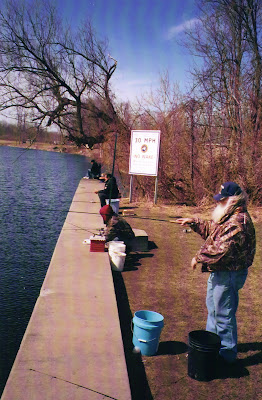 Grape Hyacinth emerging
Grape Hyacinth emergingTo the uninitiated, a posting on flowers in a fishing and hunting blog might seem kind'a off message. But the vast, silent minority who actively indulges in the natural world, finds it quite appropriate. You see, even the most fanatical angler has to tip-toe through tulips or smell the roses sometimes. And it would be impossible to find a hunter who doesn't find the silent beauty of a forest, field or marsh magical and spell binding?
April sees the colorful curtain drop. Oh sure, unseasonably warm years have been known to sprinkle the countryside in flourishes of color by late March, but this month is a sure thing: its first week fires fresh shoots through the mat of last fall's fallen leaves; the second and third weeks string clumps of lush, trembling colors over the new growth erupting over the countryside.
The wildlife management area offers two separate flowery habitats--marsh and upland-- right at the road. A tour of the place can be had in fifteen minutes or less, and you don't even have to get out of the car -- but it's more fun if you do.
Heading south on Toad Harbor Road, vibrant hues pop out of the austere-looking ground right at the first dip in the pavement. A swampy area spotted with mounds of earth--the remains of ancient tree trunks--graces your view with crops of trilliums, red and white, pushing up among emerging ferns.
About a mile later, hook a left onto McCloud Road. Just beyond the last houses, keep your eyes peeled on the left shoulder. Shortly, clumps of grape Hyacinths will appear, their purple, cone-shaped clusters towering a couple of inches above a carpet of adder's tongues (aka trout lilies).
This spot is a good place to get out and walk into the field. A chorus of peepers will sing for you as you walk among the plants. At the tree line, the floor becomes littered with weathered boulders decked out in lichens.
The trees, many well on their way to old growth, range from gnarly oaks to majestic shag-bark hickories.
Back on the road, head downhill towards Phillips Point. At the bend, adder's tongues line the shoulder, and stretch back into the woods, their yellow flowers curling back, providing a resting place for the sun's rays.
The WMA is easy to reach. Take I-81 to Central Square, exit 32. Head east on State Route 49 for three miles, turn right on Toad Harbor Road and the flower show begins beyond the golf course.
 Adder's tongues coming out
Adder's tongues coming out
Shagbark hickory








